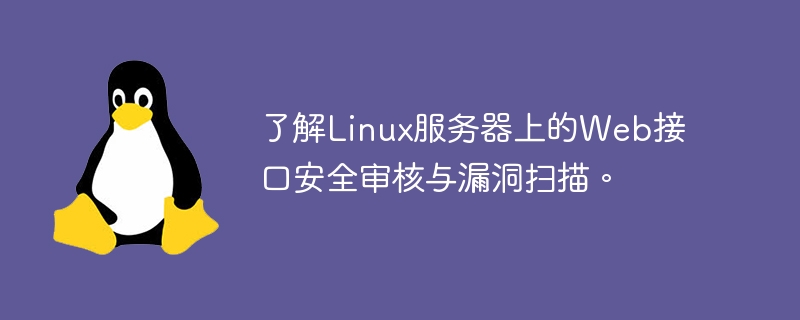Home >Operation and Maintenance >Linux Operation and Maintenance >Learn about web interface security auditing and vulnerability scanning on Linux servers.
Learn about web interface security auditing and vulnerability scanning on Linux servers.
- WBOYWBOYWBOYWBOYWBOYWBOYWBOYWBOYWBOYWBOYWBOYWBOYWBOriginal
- 2023-09-08 12:39:14811browse

Understand the Web interface security audit and vulnerability scanning on Linux servers
With the development of the Internet, the security issues of Web applications have become increasingly prominent. Especially web applications deployed on Linux servers require security audits and vulnerability scanning to ensure the security of the server. This article will introduce the basic principles and operation steps of web interface security audit and vulnerability scanning on Linux servers, and provide some code examples for readers' reference.
1. Principles and steps of Web interface security audit
Web interface security audit refers to examining the interface of a Web application to discover potential security risks and vulnerabilities. The basic principle is to identify and analyze the input and output of web applications, find possible security vulnerabilities, and provide corresponding repair suggestions.
The steps for web interface security audit are as follows:
- Collect information: Collect various information about the web application, including URL address, request parameters, form data, etc.
- Design test cases: Construct various test cases based on the collected information, such as entering illegal data, special characters, etc.
- Send a request: Use tools or manually send simulated requests to test your web application.
- Analyze response: Analyze the response of the web application to check whether there are security vulnerabilities.
- Generate report: Based on the test results, generate a detailed vulnerability scanning report and provide corresponding repair suggestions.
2. Principles and code examples of vulnerability scanning
Vulnerability scanning refers to scanning web applications through automated tools to discover security vulnerabilities. The basic principle is to test web applications based on known vulnerabilities and attack patterns, and collect corresponding response information for analysis.
The following is a simple Python code example to demonstrate how to scan using a vulnerability scanning tool:
import requests
def scan(url):
# 发送GET请求
response = requests.get(url)
# 分析响应
if response.status_code == 200:
print("Web应用程序正常运行!")
else:
print("Web应用程序存在安全问题!")
if __name__ == "__main__":
url = "http://example.com"
scan(url)In the above example, we use Python's requests library to send a GET request, and Judge the returned status code. If the status code is 200, it means the web application is running normally; otherwise, it means there is a security issue.
It should be noted that the above example is just a simple example, and actual vulnerability scanning tools are more complex and professional. In practical applications, we can use mature vulnerability scanning tools, such as Nessus, OpenVAS, etc., to improve the efficiency and accuracy of scanning.
3. Summary
Web interface security audit and vulnerability scanning are important links in ensuring the security of Web applications on Linux servers. By auditing and vulnerability scanning the web interface, potential security risks can be discovered in a timely manner and corresponding measures can be taken. This article introduces the basic principles and operational steps of web interface security audit and vulnerability scanning, and provides a simple code example for readers' reference.
In short, ensuring the security of web applications on Linux servers requires the comprehensive use of different security measures, including but not limited to web interface security audits and vulnerability scanning. Only by continuously strengthening security awareness and improving technical levels can we better protect the security of web applications and servers.
The above is the detailed content of Learn about web interface security auditing and vulnerability scanning on Linux servers.. For more information, please follow other related articles on the PHP Chinese website!

